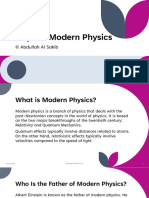0% found this document useful (0 votes)
9 views1 pageAtom Models Assignment
The document compares Thomson's and Rutherford's atomic models, explaining that atoms are the smallest units of matter. Thomson's model depicted atoms as a positively charged 'pudding' with electrons embedded, while Rutherford's model introduced the concept of a nucleus at the center with electrons orbiting around it. Both models contributed to the understanding of atomic structure, with Rutherford's model providing a more accurate explanation of atomic behavior.
Uploaded by
irsahsohaib23Copyright
© © All Rights Reserved
We take content rights seriously. If you suspect this is your content, claim it here.
Available Formats
Download as DOCX, PDF, TXT or read online on Scribd
0% found this document useful (0 votes)
9 views1 pageAtom Models Assignment
The document compares Thomson's and Rutherford's atomic models, explaining that atoms are the smallest units of matter. Thomson's model depicted atoms as a positively charged 'pudding' with electrons embedded, while Rutherford's model introduced the concept of a nucleus at the center with electrons orbiting around it. Both models contributed to the understanding of atomic structure, with Rutherford's model providing a more accurate explanation of atomic behavior.
Uploaded by
irsahsohaib23Copyright
© © All Rights Reserved
We take content rights seriously. If you suspect this is your content, claim it here.
Available Formats
Download as DOCX, PDF, TXT or read online on Scribd
/ 1



































































